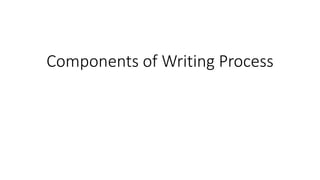
Components of Writing Process.pptx
- 1. Components of Writing Process
- 2. The following are the components of the speech writing process. • Audience analysis entails looking into the profile of your target audience. This is done so you can tailor-fit your speech content and delivery to your audience. The profile includes the following information. Q demography (age range, male-female ratio, educational background and affiliations or degree program taken, nationality, economic status, academic or corporate designations) Q situation (time, venue, occasion, and size) Q psychology (values, beliefs, attitudes, preferences, cultural and racial ideologies, and needs)
- 3. The purpose for writing and delivering the speech can be classified into three—to inform, to entertain, or to persuade. Q An informative speech provides the audience with a clear understanding of the concept or idea presented by the speaker. Q An entertainment speech provides the audience with amusement. Q A persuasive speech provides the audience with well-argued ideas that can influence their own beliefs and decisions.
- 4. The topic is your focal point of your speech, which can be determined once you have decided on your purpose. If you are free to decide on a topic, choose one that really interests you. There are a variety of strategies used in selecting a topic, such as using your personal experiences, discussing with your family members or friends, free writing, listing, asking questions, or semantic webbing. • Narrowing down a topic means making your main idea more specific and focused. The strategies in selecting a topic can also be used when you narrow down a topic. In the example below, “Defining and developing effective money management skills of Grade 11 students” is the specific topic out of a general one, which is “Effective money management.”
- 5. • Data gathering is the stage where you collect ideas, information, sources, and references relevant or related to your specific topic. This can be done by visiting the library, browsing the web, observing a certain phenomenon or event related to your topic, or conducting an interview or survey. The data that you will gather will be very useful in making your speech informative, entertaining, or persuasive. • Writing patterns, in general, are structures that will help you organize the ideas related to your topic. Examples are biographical, categorical/topical, causal, chronological, comparison/contrast, problem-solution, and spatial.
- 6. • An outline is a hierarchical list that shows the relationship of your ideas. Experts in public speaking state that once your outline is ready, two-thirds of your speech writing is finished. A good outline helps you see that all the ideas are in line with your main idea or message. The elements of an outline include introduction, body, and conclusion. Write your outline based on how you want your ideas to develop. Below are some of the suggested formats.
- 7. The following are some strategies to highlight your main idea. Q Present real-life or practical examples Q Show statistics Q Present comparisons Q Share ideas from the experts or practitioners
- 8. • The introduction is the foundation of your speech. Here, your primary goal is to get the attention of your audience and present the subject or main idea of your speech. Your first few words should do so. The following are some strategies. • Q Use a real-life experience and connect that experience to your subject. • Q Use practical examples and explain their connection to your subject. • Q Start with a familiar or strong quote and then explain what it means. • Q Use facts or statistics and highlight their importance to your subject. • Q Tell a personal story to illustrate your point.
- 9. • The conclusion restates the main idea of your speech. Furthermore, it provides a summary, emphasizes the message, and calls for action. While the primary goal of the introduction is to get the attention of your audience, the conclusion aims to leave the audience with a memorable statement. The following are some strategies. Q Begin your conclusion with a restatement of your message. Q Use positive examples, encouraging words, or memorable lines from songs or stories familiar to your audience. Q Ask a question or series of questions that can make your audience reflect or ponder
- 10. • Editing/Revising your written speech involves correcting errors in mechanics, such as grammar, punctuation, capitalization, unity, coherence, and others. Andrew Dlugan (2013), an awardwinning public speaker, lists six power principles for speech editing. Q Edit for focus. “So, what’s the point? What’s the message of the speech?” Ensure that everything you have written, from introduction to conclusion, is related to your central message
- 11. • Edit for clarity. “I don’t understand the message because the examples or supporting details were confusing.” Make all ideas in your speech clear by arranging them in logical order (e.g., main idea first then supporting details, or supporting details first then main idea). • Q Edit for concision. “The speech was all over the place; the speaker kept talking endlessly as if no one was listening to him/her.” Keep your speech short, simple, and clear by eliminating unrelated stories and sentences and by using simple words.
- 12. Reference • LM Oral Com.pdf